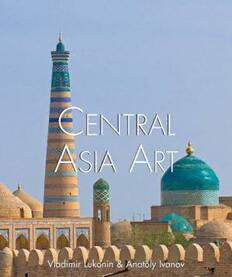
Central Asian Art PDF
Preview Central Asian Art
CC EENNTTRRAALL AA AA SSIIAA RRTT VVllaaddiimmiirr LLuukkoonniinn && AAnnaattoollyy IIvvaannoovv Author: Vladimir Lukonin and Anatoli Ivanov Layout: Baseline Co. Ltd 61A-63A Vo Van Tan Street 4th Floor District 3, Ho Chi Minh City Vietnam © Confidential Concepts, worldwide, USA © Parkstone Press International, New York, USA IImmaaggee--BBaarr www.image-bar.com All rights reserved. No part of this publication may be reproduced or adapted without the permission of the copyright holder, throughout the world. Unless otherwise specified, copyright on the works reproduced lies with the respective photographers, artists, heirs or estates. Despite intensive research, it has not always been possible to establish copyright ownership. Where this is the case, we would appreciate notification. ISBN: 978-1-78042-894-9 2 Vladimir Lukonin and Anatoli Ivanov Central Asian Art 3 Contents A Brief Glance at History 7 Architecture 25 Sculpture 59 Monumental Painting and Illumination 83 The Decorative Arts 103 Three Pearls on the Silk Road 191 Map of Central Asia 250 Index 252 5 6 A Brief Glance at History Central Asia, ancient territory where nature offers contrasts different from any other area of the world, traditionally regroups four republics of the community of Independent States: Kyrgyzstan, Tajikistan, Turkmenistan, and Uzbekistan, extending from the Caspian Sea to the Chinese border. Broad deserts and flourishing orchards and vineyards, snow-covered mountains and green valleys, old abandoned cities, traditional villages and modern towns proud of their past – often several thousand years old, and with famous monuments – may be found here. Centre of successive civilisations and multiple cultures, this vast area claims an exceptional architectural, artistic, and handicraft heritage. Ever since the Bronze Age and the beginning of the Iron Age, Central Asia has rivalled with classical Eastern Asia (which extended from Mesopotamia to India) in the abilities and skills of its peoples. In the 6th century BCE it was largely conquered by the powerful Achaemenian Dynasty and in the 4th century BCE by Alexander the Great’s army which gave it considerable artistic impetus. The period between the 3rd century BCE and the 3rd century CE marked the area with the appearance of powerful Kingdoms: the Parthians of the Arsacid dynasty (south of Turkmenistan, in Persia, and in part of Mesopotamia), the Greco-Bactrians, the Kushans (which included Bactria and the territory beyond Amu-Daria as far as the Indus and the Ganges), the Kangas (that united the Kharezm, the Sogdian, and the northern territories) whose social and cultural development founded an entirely new cultural impulse throughout the territory they controlled. If the development of the arts in Central Asia was closely linked with their neighbours, this period was nevertheless marked by a conjunction of influences, Hellenistic, Indo-Buddhist, and South Persian, whereas in the North-East, the central territories, the Sakas, and the Scythians, left the imprint of their own traditions. But Fresco, Abdul Aziz Madrasa. the local artists didn’t satisfy themselves with copying shapes and designs alien to Bukhara, Uzbekistan. them, but modified, according to their sensibility, the forms and the content of Kazi Zade Rumi Mausoleum. foreign cultures. They worked with their own ancestral techniques and according to Samarkand, Uzbekistan. (p. 4) their aesthetic sense and ideology, thus giving birth to a new art profoundly original The Ark, fortress walls. at the threshold of the 4th century BCE. Bukhara, Uzbekistan. (pp. 8-9) 7 The fall of the ancient empires of Central Asia and the invasions of the 4th and 5th centuries by wandering tribes from the North predetermined the establishment of a new social order, an intensive feudal system, and the constitution of a great number of semi-independent principalities. It was a period of domination by rich landowners who lived in innumerable fortresses scattered in the plains and mountains. One of the most remarkable characteristics of this renewed social system was the formation of a particular type of medieval culture in the towns, then few in number, and the development of many crafts in different artistic areas. The political dismemberment encouraged the conquest of the region by the Arabs and its submission to the caliphate power from the 7th century. It was at this time that all the countries between the Amu Darya and Zhetysu (previously known as Semirechyez, the Seven Rivers region) was named Mavera-un-Nahr. The south of today’s Turkmenistan became a part of the Khorasan region. From this time, only Khwarezm retained its former name. A part of the patrimony, including mural paintings, sculptures, and representative figures opposed to the Arab laws about ornament, was destroyed during that period, but at the same time, many aspects of artistic life were influenced by Muslim culture. During the 10th through 12th centuries, art was once again faced with many sudden changes. Ancient traditions were abandoned, the development of monumental paintings and sculptures ceased, and the ornamental, decorative style common to all Islamic countries in architecture and the applied arts became the main source of creation. On political grounds, the local noblemen, even if they were nominally subjects of the caliphate, began to conduct their states with total independence from the 9th and 10th centuries. At last, at the beginning of the 11th century, following the numerous Turkmen invasions, the Turkmen dynasties established themselves in this region. This period favoured the development of urban culture and the growth of towns, among which Merv – today abandoned – Samarkand, Khiva, and Bukhara remained representative of the essential spirit. Around 1150, the architecture of Central Asia was monochrome, but in the middle of the 12th century blue brick began to be used and considerable Tilya-Kori Madrasah. Samarkand, Uzbekistan. progress was made in the art of building and decorative ornamentation. 10
